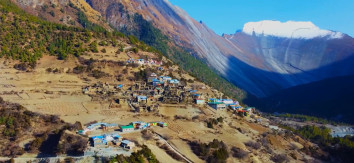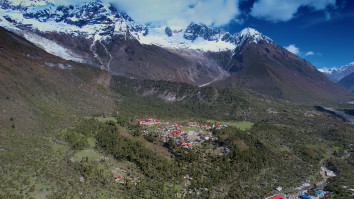
Pashupatinath Temple, located on the banks of the Bagmati River in Kathmandu, Nepal, is one of the most revered Hindu temples in the world. Dedicated to Lord Shiva, this UNESCO World Heritage Site is a pivotal pilgrimage destination that attracts thousands of devotees and tourists annually. This article delves into the temple's history, cultural significance, rituals, and practical information for visitors.
Pashupatinath Temple's origins trace back to 400 AD, although the current structure was built in the 17th century by King Bhupatindra Malla after the original building was destroyed by termites. The temple's name, Pashupatinath, translates to "Lord of the Animals," reflecting Lord Shiva's role as the protector of all living beings. Over the centuries, the temple has been an important center of Hindu spiritual practice and is considered one of the holiest Shiva temples in the world.
Situated approximately 3 kilometers east of Kathmandu's city center, Pashupatinath Temple lies on the western bank of the Bagmati River. This strategic location not only enhances its spiritual ambiance but also makes it easily accessible from various parts of the city. The temple complex is surrounded by lush greenery and dotted with numerous smaller temples and shrines.
Pashupatinath Temple is a cornerstone of Hindu culture and spirituality. It is believed that visiting the temple and worshipping Lord Shiva here can absolve devotees of their sins and ensure a peaceful afterlife. The temple complex, with its intricate wood carvings and pagoda-style architecture, is a masterpiece of Nepalese craftsmanship. The sacred lingam of Pashupatinath, enshrined within the temple, is a focal point of veneration and spiritual reflection for devotees.
The daily rituals at Pashupatinath are an integral part of its spiritual atmosphere. These include the morning and evening aarti (worship with light) performed by priests, which are accompanied by chanting, bell ringing, and the blowing of conch shells. One of the most profound ceremonies is the offering of water, milk, and bel leaves to the sacred Shiva lingam. Additionally, the Bagmati River, which flows beside the temple, is considered holy, and ritual bathing in its waters is believed to purify one's soul.
Pashupatinath Temple is the epicenter of several major Hindu festivals. The most significant is Maha Shivaratri, dedicated to Lord Shiva, which sees an influx of thousands of pilgrims from Nepal and India. The festival involves all-night vigils, fasting, and the offering of special prayers. Another important festival is Teej, where women gather to pray for marital bliss and the well-being of their husbands. During these festivals, the temple complex is adorned with lights and decorations, and the atmosphere is charged with devotional fervor.
Pashupatinath Temple is conveniently located approximately 2 kilometers from Tribhuvan International Airport, making it easily accessible for visitors arriving in Kathmandu. The short journey from the airport to the temple typically takes around 5-10 minutes by car or taxi, depending on traffic conditions. Or you can walk for 10 minutes from airport gate to Pashupatinath Gate directly through Tilganga side gate.
The best time to visit Pashupatinath Temple is during the autumn (September to November) and spring (March to May) seasons when the weather is mild and pleasant. These periods also coincide with major festivals, offering visitors a chance to experience the temple's vibrant cultural and spiritual life. Early mornings and late afternoons are ideal times to visit to avoid the crowds and witness the serene rituals performed at the temple.
Pashupatinath Temple is not just a monument of architectural splendor but a living symbol of Nepal's rich spiritual heritage. Its profound cultural and religious significance, combined with the daily rituals and vibrant festivals, make it a compelling destination for both devotees and tourists. Whether you seek spiritual solace, cultural insight, or historical knowledge, a visit to Pashupatinath Temple promises an enriching and unforgettable experience. Kathmandu valley tour offers Pashupatinath temple tour in its package.
 Discover Pisang Village, a scenic stop on the Annapurna Circuit Trek. Experience stunning Himalayan views, local culture, and peaceful mountain charm in Nepal's Manang District.
Discover Pisang Village, a scenic stop on the Annapurna Circuit Trek. Experience stunning Himalayan views, local culture, and peaceful mountain charm in Nepal's Manang District.
 Discover Chame Village, a scenic gateway to the Annapurna Circuit and Himalayan treks like Tilicho Lake and Nar Phu Valley. Learn about its culture, location, attractions, and trekking routes.
Discover Chame Village, a scenic gateway to the Annapurna Circuit and Himalayan treks like Tilicho Lake and Nar Phu Valley. Learn about its culture, location, attractions, and trekking routes.
 Explore Besisahar, the gateway to the Annapurna Circuit in Nepal. Discover scenic landscapes, local culture, trekking routes, and travel tips for your Himalayan adventure.
Explore Besisahar, the gateway to the Annapurna Circuit in Nepal. Discover scenic landscapes, local culture, trekking routes, and travel tips for your Himalayan adventure.
 Lobuche Village Nepal: know the weather, location, tea houses, restaurants, altitude, near by location of Lobuche, all info you need to know about
Lobuche Village Nepal: know the weather, location, tea houses, restaurants, altitude, near by location of Lobuche, all info you need to know about
 Discover Tilije Village, a serene stop on the Manaslu Circuit Trek in Nepal. Surrounded by mountains and Tibetan culture, it's the perfect place to rest, explore, and experience authentic Himalayan hospitality.
Discover Tilije Village, a serene stop on the Manaslu Circuit Trek in Nepal. Surrounded by mountains and Tibetan culture, it's the perfect place to rest, explore, and experience authentic Himalayan hospitality.
 Discover Bhimtang Village, a scenic stop on the Manaslu Circuit Trek. Surrounded by glaciers and alpine beauty, it offers cozy lodges, mountain views, and cultural charm at 3,720 meters.
Discover Bhimtang Village, a scenic stop on the Manaslu Circuit Trek. Surrounded by glaciers and alpine beauty, it offers cozy lodges, mountain views, and cultural charm at 3,720 meters.
 Discover Dharamshala in Nepal, a peaceful rest and acclimatization stop on the Manaslu Circuit Trek. Enjoy stunning mountain views, cozy lodges, and prepare for the challenging Larkya La Pass ahead.
Discover Dharamshala in Nepal, a peaceful rest and acclimatization stop on the Manaslu Circuit Trek. Enjoy stunning mountain views, cozy lodges, and prepare for the challenging Larkya La Pass ahead.
 Discover Samdo Village, a remote Himalayan settlement near the Tibetan border. Explore its unique Tibetan culture, scenic landscapes, and its role as the last stop before crossing Larkya La Pass on the Manaslu Circuit Trek.
Discover Samdo Village, a remote Himalayan settlement near the Tibetan border. Explore its unique Tibetan culture, scenic landscapes, and its role as the last stop before crossing Larkya La Pass on the Manaslu Circuit Trek.
 Discover Samagaun Village in Nepal, a scenic stop on the Manaslu Circuit Trek known for its Tibetan culture, mountain views, and peaceful Himalayan charm.
Discover Samagaun Village in Nepal, a scenic stop on the Manaslu Circuit Trek known for its Tibetan culture, mountain views, and peaceful Himalayan charm.
 Explore Shyala Village on the Manaslu Trek and enjoy stunning views and rich culture. Plan your Himalayan adventure now!
Explore Shyala Village on the Manaslu Trek and enjoy stunning views and rich culture. Plan your Himalayan adventure now!
All contents Within this website is copyright Protected © 2025 | Adventure Vision Treks and Travels Pvt. Ltd.